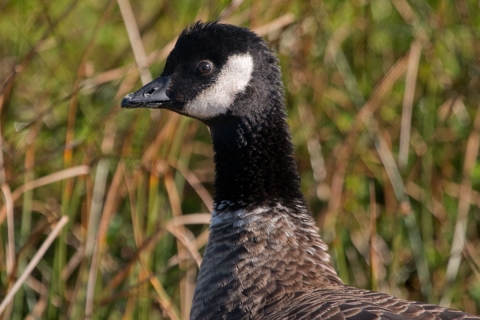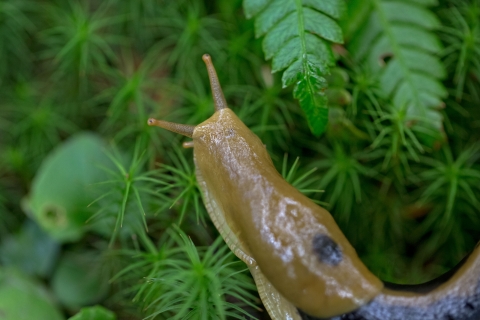Seasons of Wildlife
Spring
Early-blooming plants brighten the refuge in the still-rainy days of spring. Small, purple, early blue violets dot the edges of the Prairie, growing to support the experimental population of the threatened Oregon Silverspot Butterfly. Other early-bloomers include skunk cabbage, fawn lily, and Siberian spring beauty.
Flocks of migrating birds and waterfowl swell the ranks of resident and overwintering populations at Nestucca Bay NWR. Some stop only briefly on the estuary to feed and rest, soon resuming their migration north to Arctic breeding areas. Some stay, joining resident populations that will court and build nests in the marshes, meadows, and forests.
Some estuaries are host to spring migrations of anadromous fish on their way to freshwater spawning grounds. Spring Chinook Salmon usually arrive in May, while Coho Salmon and Cutthroat Trout typically arrive late summer into fall.
Summer
Blooming prairies atop Cannery Hill treat both visitors and pollinators of the refuge. Songbirds dart through the trees of the Two Rivers Nature Trail seeking meals to deliver to their hidden nests.
On the marshes and backwaters of the estuaries, Mallard, Wood Duck, and merganser parents trail trains of fuzzy ducklings behind them. Returning Brown Pelicans, so graceful on the wing, make crashing spectacles of themselves when they spot forage fish swimming below. They tuck their wings, stretch their necks, and simply let gravity take its course. They're a summer delight, and their numbers are increasing along Oregon's coastal bays and estuaries—a hopeful sign for a species nearly wiped out in the 1970s by DDT poisoning.
Fall
Thousands of shorebirds migrate along the Oregon coast in the fall, using estuaries as stopover habitat to feed and rest. Shorebird numbers peak in September as they fly south to wintering areas. Of waterfowl, tiny Green-winged Teal are often the first to show up, usually in September, in their sporadic, darting-and-diving flocks. The first bad weather up north drives other dabblers down—the Mallards, Pintails and Gadwalls. After Thanksgiving, diving ducks pour in with every storm front.
Raptors such as Sharp-shinned Hawks monitor the estuary's margins, alert to unsuspecting prey birds. Nestucca Bay is an excellent place to watch migrating shorebirds and waterfowl—especially the many thousands of white-cheeked geese (all varieties of Canada and Cackling geese, divided into six subspecies) that crowd its verdant pastures from October to April.
Winter
Mushrooms, newts, salamanders and banana slugs dot the forest floor after winter rains. Sea ducks, waterfowl and shorebirds such as Wilson's Snipe are abundant during the winter. Common species include Surf, White-winged and Black Scoters, Buffleheads, Common and Pacific Loons; and Western, Horned and Red-Necked Grebes. Estuaries host wintering ducks, geese, and a variety of raptors. From the vantage atop Cannery Hill, Gray Whales can be seen migrating south along the coast in December and January on their journey to calving grounds in the coastal lagoons of Baja Mexico.
Featured Species
Nestucca Bay NWR is a haven for wildlife at all times of year. The refuge harbors many species of native and migratory songbirds, sylvan and estuarine mammals, and waterfowl. For those wanting to see thousands of wintering white-cheeked geese, including the only coastal wintering population of Dusky Canada Geese and the small population of Semidi Islands Aleutian Cackling Geese, a visit late October to early April is ideal. The refuge is also home to an experimental population of the threatened Oregon Silverspot Butterfly, who relies on the dwindling coastal prairie habitat.




